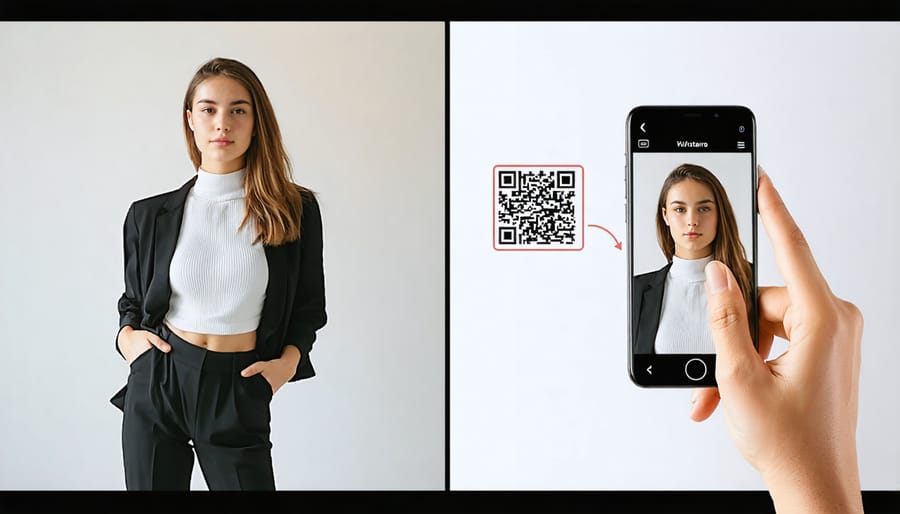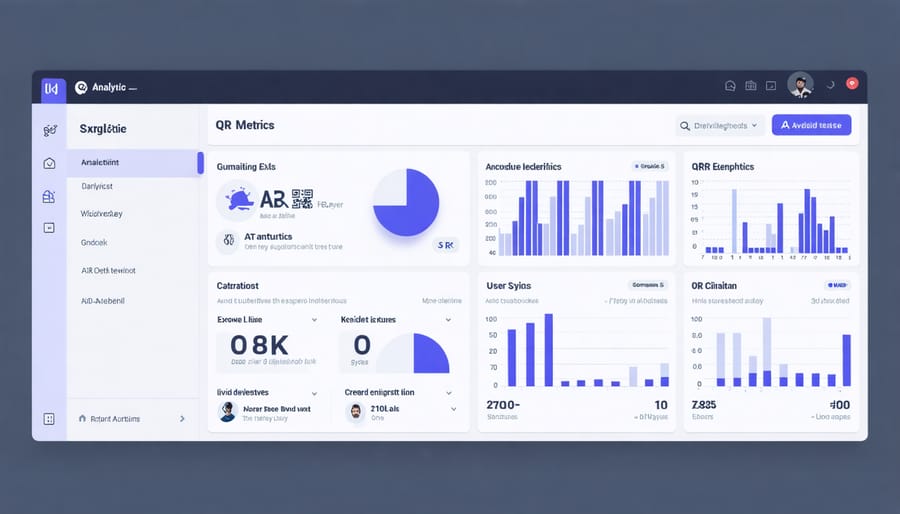QR-Powered AR: Transform Your Customer Experience Today

QR-powered augmented reality applications are revolutionizing how businesses create personalized customer experiences in retail, education, and marketing. By merging physical products with digital content, these applications enable instant access to interactive 3D models, product demonstrations, and immersive brand storytelling through a simple smartphone scan. Major brands like IKEA, Nike, and L’Oréal have already deployed QR-AR solutions to boost engagement rates by 40% and increase conversion rates up to 25%. For business owners and marketers, implementing QR-AR technology offers a cost-effective way to bridge the digital-physical divide, provide real-time product information, and capture valuable customer interaction data. As mobile AR technology becomes increasingly sophisticated, QR codes serve as the perfect gateway for businesses to deliver enhanced customer experiences without requiring specialized hardware or complex technical infrastructure.
How QR-Based AR Applications Work
The Basic Components
QR-AR applications consist of three fundamental components that work together seamlessly. First, QR codes serve as visual triggers that can be easily scanned by smartphones. These unique patterns store information and act as bridges between physical materials and digital content. Second, AR markers function as reference points that help position and orient virtual elements in the real world through your device’s camera view. These markers can be either the QR codes themselves or separate visual indicators.
The third essential component is a compatible smartphone or tablet with the necessary hardware and software capabilities. Modern devices require a camera, adequate processing power, and specific AR-enabled applications to interpret the QR codes and display augmented content. Most current smartphones come equipped with built-in QR readers and AR capabilities, making implementation straightforward for businesses and accessible for customers. Together, these components create an interactive experience that blends digital information with the physical environment.

The User Experience Flow
The typical user experience with QR-AR applications follows a straightforward process that begins when customers encounter a QR code in their environment. Using their smartphone’s camera or a QR scanner app, they simply point their device at the code. Once scanned, the application automatically launches, and the AR experience begins immediately.
The AR content then appears on the user’s screen, overlaying digital elements onto the real world through their device’s camera view. Users can interact with these virtual elements by tapping, swiping, or moving their device around the physical space. Some applications offer additional features like saving content, sharing on social media, or making direct purchases through the AR interface.
For business implementations, the process typically includes clear instructions near the QR code to guide first-time users. The entire interaction should take no more than a few seconds from scan to display, ensuring a smooth, engaging experience that keeps customers interested and encourages repeated use.
Practical Business Applications
Retail and Product Visualization
Retailers are revolutionizing the shopping experience by combining QR codes with augmented reality to create immersive product demonstrations. When customers scan QR codes on packaging or marketing materials, they can instantly view 3D models of products, explore features, and even virtually try items before purchase.
Fashion retailers use QR-AR technology to let customers virtually try on clothing, accessories, and makeup products from their smartphones. Furniture stores enable shoppers to visualize how pieces would look in their homes through AR placement. Electronics retailers demonstrate product features through interactive 3D models that appear when customers scan QR codes on display items.
This technology significantly reduces return rates as customers make more informed purchasing decisions. Major retailers report up to 40% higher conversion rates when implementing QR-AR solutions in their stores and catalogs. Small businesses can also benefit by using affordable QR-AR platforms to create virtual showrooms and product demonstrations.
The integration of QR-AR in retail provides valuable analytics about customer interaction with products, helping businesses optimize their merchandising strategies and improve the overall shopping experience. This technology bridges the gap between online and offline shopping, creating a seamless omnichannel experience that modern consumers expect.

Interactive Marketing Materials
Interactive marketing materials have revolutionized traditional print advertising through QR-AR integration. Product packaging now comes alive when scanned, showing 3D product demonstrations, usage instructions, or behind-the-scenes content. Magazine advertisements transform into immersive experiences, allowing readers to virtually try products or explore additional features through their smartphones.
Retail displays and promotional posters leverage QR-AR to create engaging storefront experiences. For example, clothing retailers use QR codes that let customers view different color options or styling suggestions when scanned. Restaurant menus with QR-AR capabilities display 3D renderings of dishes, complete with ingredient information and preparation methods.
Business cards and brochures become dynamic networking tools, instantly connecting to digital portfolios, video presentations, or social media profiles. Event materials like conference badges or festival posters can trigger AR experiences showing schedules, maps, or exclusive content, making printed materials more valuable and engaging for audiences while providing measurable engagement metrics for marketers.
Customer Education and Support
QR-AR technology revolutionizes customer education and support by providing instant, interactive guidance when and where customers need it most. By scanning a QR code on a product, customers can access detailed 3D assembly instructions, maintenance guides, and troubleshooting tutorials through augmented reality overlays. This visual approach significantly reduces support calls and customer frustration while improving product understanding.
Businesses can embed how-to videos, multilingual instructions, and real-time support options directly into their products through QR-AR integration. For example, furniture retailers can show assembly steps in AR, while appliance manufacturers can guide users through maintenance procedures with virtual markers and animations.
The technology also enables interactive user manuals that update automatically, ensuring customers always have access to the latest product information. This dynamic support system not only enhances the customer experience but also reduces printing costs and environmental impact associated with traditional paper manuals.
Implementation Strategy
Choosing the Right QR-AR Platform
When selecting a QR-AR platform for your business, consider these key factors to ensure you make the right choice. First, evaluate the platform’s ease of use – both for your team during content creation and for your customers during interaction. Look for intuitive interfaces and straightforward implementation processes.
Cost structure is crucial; examine not just the initial setup fees but also ongoing maintenance costs, content hosting fees, and any charges per scan or interaction. Some providers offer tiered pricing models that can scale with your business needs.
Platform reliability and technical support should be top priorities. Ensure the provider maintains high server uptime and offers responsive customer service. Check if they provide analytics tools to track engagement metrics and campaign performance.
Content creation capabilities vary significantly between platforms. Some offer drag-and-drop editors while others require technical expertise. Consider whether you need features like 3D object support, video integration, or real-time content updates.
Security features and data privacy compliance are non-negotiable. Verify that the platform adheres to relevant data protection regulations and offers secure content delivery methods. Finally, look for providers with proven track records and positive client testimonials in your industry.
Content Creation and Management
When creating content for QR-triggered AR experiences, focus on developing clear, engaging, and purposeful materials that add genuine value for users. Start by defining specific objectives for your AR content, whether it’s product visualization, interactive tutorials, or immersive brand storytelling. Ensure your 3D models, animations, or interactive elements are optimized for mobile devices to maintain smooth performance.
Keep file sizes manageable and use compression techniques to reduce loading times without compromising quality. Consider your target audience’s technical capabilities and design content that’s intuitive to navigate. Implement clear call-to-actions within the AR experience to guide users toward desired outcomes.
Regular content updates are crucial for maintaining user engagement. Establish a content calendar for refreshing AR experiences and monitor user interaction metrics to identify areas for improvement. Test your AR content across different devices and lighting conditions to ensure consistent performance. Remember to include fallback options for devices that may not support certain AR features.
Measuring Success
To measure the success of your QR-AR campaigns, focus on key performance indicators (KPIs) that align with your business objectives. Track scan rates to understand how many users interact with your QR codes, and monitor engagement time to assess the effectiveness of your AR experiences. Conversion rates and click-through rates provide insights into whether users take desired actions after experiencing your AR content.
Implement comprehensive digital marketing analytics to measure user behavior patterns, including repeat engagement rates and social sharing metrics. Pay attention to geographic and demographic data to refine targeting strategies. Customer feedback and satisfaction scores offer valuable qualitative insights to complement quantitative metrics.
Set clear benchmarks for these metrics and regularly review performance data to optimize your campaigns. Consider tracking ROI by comparing campaign costs against generated leads, sales, or brand awareness improvements. This data-driven approach ensures your QR-AR initiatives deliver measurable business value while meeting customer expectations.

Future-Proofing Your QR-AR Strategy
To maintain a competitive edge in the rapidly evolving QR-AR landscape, businesses must adopt a forward-thinking approach to their implementation strategy. Start by ensuring your QR codes are adaptable and updatable without requiring complete system overhauls. This flexibility allows you to modify content and experiences without disrupting existing customer touchpoints.
Integration with AI-powered marketing strategies is becoming increasingly crucial for personalizing AR experiences. Consider implementing dynamic QR codes that can adjust content based on user behavior, time of day, or location data. This adaptability ensures your marketing remains relevant and engaging over time.
Data security and privacy considerations should be at the forefront of your strategy. Implement robust encryption methods for QR codes and ensure compliance with evolving data protection regulations. Regular security audits and updates will help maintain user trust and protect sensitive information.
Keep an eye on emerging technologies like WebAR, which eliminates the need for standalone apps, and 5G connectivity, which will enable more sophisticated AR experiences. Consider investing in scalable infrastructure that can accommodate these advancements without requiring complete system rebuilds.
Finally, maintain a testing and optimization schedule to ensure your QR-AR implementations remain effective. Regular performance assessments and user feedback collection will help you identify areas for improvement and keep your strategy aligned with changing customer expectations.
QR-enabled augmented reality applications represent a powerful tool for modern businesses looking to enhance customer engagement and streamline operations. By combining the accessibility of QR codes with the immersive experience of AR, companies can create memorable interactions that drive results. Whether you’re looking to improve product demonstrations, enhance marketing materials, or create interactive customer experiences, QR-AR technology offers a cost-effective and scalable solution. The time to implement this technology is now, as consumer adoption continues to grow and implementation barriers decrease. Take the first step by identifying areas in your business where QR-AR applications could add value, and start small with a pilot project. With the right strategy and execution, these applications can significantly impact your bottom line while positioning your business at the forefront of digital innovation.
Leave a Reply